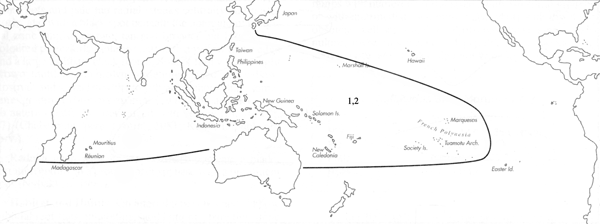Range: C. t. terebra: E. Africa to Marquesas, Amami Is., and Australia; C. t. thomasi: Red Sea and Gulf of Aden.
Description: Medium-sized to large, moderately solid to solid. Last whorl conical, also narrowly conical in C. t. terebra (Pl. 31, Figs. 16-20); outline convex below shoulder, straight below, sometimes concave centrally. Shoulder rounded, sometimes rather indistinct from spire. Spire usually of moderate height, occasionally low; outline convex. Larval shell multispiral, maximum diameter about 0.8 mm. First 3-5 postnuclear whorls tuberculate. Teleoconch sutural ramps slightly convex to slightly concave, with 1 increasing to 3-4 wide spiral grooves and additional striae or with numerous striae. Last whorl with variably spaced and variably fine spiral ribs from base to shoulder, weaker in large specimens of C. t. thomasi (Pl. 31, Figs. 21, 22); interspaces may have spiral threads.
| Shell Morphometry | ||
|---|---|---|
| L | - mm | |
| RW | - g/mm | |
| RD | - | |
| PMD | - | |
| RSH | - | |
Ground colour white to bluish white. Last whorl with a broad spiral band on each side of centre, varying from violet-grey to yellow brown. Base may be tinged with violet or yellow. Larval shell and adjacent 1-2 sutural ramps bluish violet. Late sutural ramps irregularly tinged with brown. Aperture white, sometimes pale blue to violet; anterior edge violet in specimens with a violet base.
Periostracum dark brown, thick, opaque, and axially ridged; darker and rough in large specimens.
Dorsum of foot greyish yellow mottled with grey and tan to orangish or reddish brown, grading to solid yellowish grey on latero-posterior marginal zones; a black spot beneath the operculum and a large, solid or interrupted black transverse band on anterior part followed by a buff area medially. Sole of foot pale yellow, washed with tan posteriorly. Rostrum pale yellow to light orange or light brown; distal zone may be dark yellow. Proboscis yellow; penis white. Tentacles long, pale yellow to orange. Siphon broad and flaring; anterior part yellow fading to white proximally, distal edge may be orange; adjacent part with black, yellow and broad grey to black transverse bands; proximal part yellow mottled with grey (Pl. 76, Fig. 48) (Chaberman, pers. comm., 1981; Kohn, unpubl. observ.; Fainzilber et al., 1992).
Radular teeth with an adapical barb opposite a blade; long serration extends beyond the centre of the shaft, terminating in a backward-pointing cusp; base with a prominent spur (Peile, 1939; Kohn, unpubl. observ.). The tooth depicted by Bandel (1984) for C. t. thomasi (Port Sudan, Red Sea) differs in having a somewhat shorter serration.
Habitat and Habits: In 0.5-20 m on coral reef or lagoon pinnacles, in fine sand with or without sea-weed and coral rubble; reported from sheltered sites beneath coral rocks and from exposed rocky areas. C. terebra feeds on terebellid polychaetes (Kohn, 1960; Kohn & Nybakken, 1975; Chaberman, pers. comm., 198 1; Sharabati, 1984; Tirard, pers. comm., 1989; Grosch, pers. comm., 1989; Fainzilber et al., 1992).
Discussion: C. terebra is similar to C. virgo and C. emaciates. C. virgo attains larger size, is heavier in similarly sized specimens and generally has a lower spire; it is distinguished by the absence of spiral colour bands from its last whorl, its smoother surface and its angulate shoulder. C. emaciates is a smaller species, has a usually more conical last whorl (PMD 0.89-0.94), a more angulate shoulder and a more uniform colouration. We provisionally distinguish C. terebra thomasi, from the Red Sea and Gulf of Aden, as a subspecies based on the smoother last whorl with generally weak spiral ribs. C. t. thomasi intergrades with C. t. terebra in all shell characters. Fainzilber et al. (1992) favour the status of a form rather than that of a subspecies.

C. terebra range map
This section contains verbatim reproductions of the accounts of 316 species of Conus from the Indo-Pacific region, from Manual of the Living Conidae, by Röckel, Korn and Kohn (1995). They are reproduced with the kind permission of the present publisher, Conchbooks.
All plates and figures referred to in the text are also in Röckel, Korn & Kohn, 1995. Manual of the Living Conidae Vol. 1: Indo-Pacific Region.
The range maps have been modified so that each species account has it own map, rather than one map that showed the ranges of several species in the original work. This was necessary because each species account is on a separate page on the website and not confined to the order of accounts in the book.